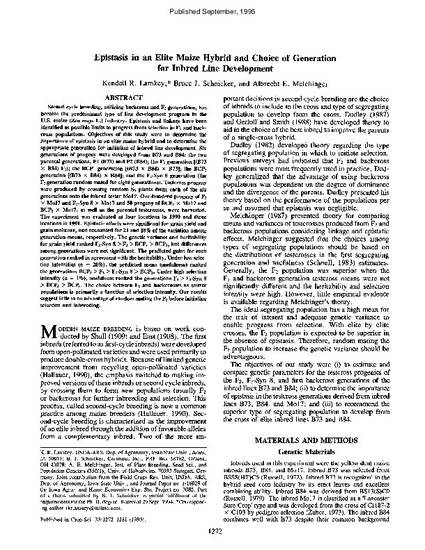
Second cycle breeding, utilizing backcross and F2 generations, has become the predominant type of line development program in the U.S. maize (Zea mays L.) industry. Epistasis and linkage have been identified as possible limits to progress from selection in F2 and backcross populations. Objectives of this study were to determine the importance of epistasis in an elite maize hybrid and to determine the appropriate generation for initiation of inbred line development. Six generations of progeny were developed from B73 and B84: the two parental generations, Pl (B73) and P2 (B84); the F2 generation [(B73 × B84) F2]; the BCP1 generation [(B73 × B84) × B73]; the BCP2 generation [(B73 × B84) × B84]; and the F2-Syn 8 generation (the F2 generation random mated for eight generations). Testcross progeny were produced by crossing random S9 plants from each of the six generations onto the inbred tester Mo17. One-hundred progeny of F2 × Mo17 and F2-Syn 8 × Mo17 and 50 progeny of BCP1 × Mo17 and BCP2 × Mo17, as well as the parental testcrosses, were harvested. The experiment was evaluated at four locations in 1990 and three locations in 1991. Epistatic effects were significant for grain yield and grain moisture, and accounted for 21 and 18% of the variation among generation means, respectively. The genetic variance and heritability for grain yield ranked F2-Syn 8 > F2 > BCP1 > BCP2, but differences among generations were not significant. The predicted gains for each generation ranked in agreement with the heritability. Under low selection intensities (a = 20%), the predicted mean (usefulness) ranked the generations BCP22 > F2 >> F2-Syn 8 > BCPI. Under high selection intensity (a = 1%), usefulness ranked the generations F2 > F2-Syn 8 > BCP2 > BCP1. The choice between F2and backcrosses as source populations is primarily a function of selection intensity. Our results suggest little to no advantage of random mating the F2 before initiating selection and inbreeding.
Available at: http://works.bepress.com/kendall_lamkey/40/

This article is published as Lamkey, Kendall R., Bruce J. Schnicker, and Albrecht E. Melchinger. "Epistasis in an elite maize hybrid and choice of generation for inbred line development." Crop science 35, no. 5 (1995): 1272-1281. doi: 10.2135/cropsci1995.0011183X003500050004x. Posted with permission.